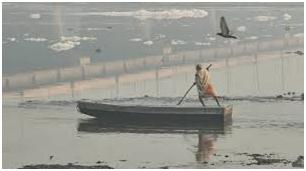Ammonia levels in the river Yamuna, almost six times above the acceptable limit
- Posted By
10Pointer
- Categories
Pollution
- Published
4th Nov, 2020
-

- The acceptable maximum limit of ammonia in drinking water, as per the Bureau of Indian Standards, is 0.5 ppm. In Yamuna it has reached, nearly 3 parts per million (ppm).
- Ammonia is a colorless gas and is used as an industrial chemical in the production of fertilizers, plastics, synthetic fibres, dyes and other products.
- It consists of hydrogen and nitrogen.
- In its aqueous form, it is called ammonium hydroxide.
- This inorganic compound has a pungent smell.
- Ammonia occurs naturally in the environment from the breakdown of organic waste matter.
- It is lighter than air Contamination: It may find its way to ground and surface water sources through industrial effluents or through contamination by sewage.
- If the concentration of ammonia in water is above 1 ppm it is toxic to fishes.
- In humans, long term ingestion of water with high levels of ammonia may cause damage to internal organs.
- Source: The most likely source is believed to be effluents from dye units, distilleries and other factories in Panipat and Sonepat districts in Haryana, and also sewage from some un-sewered colonies in this stretch of the river.
- Delhi dependent on Haryana for up to 70 per cent of its water needs. Haryana, with a large number of people involved in agriculture, has water paucity issues of its own.